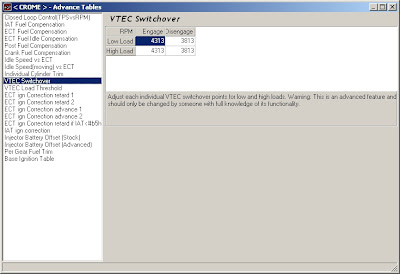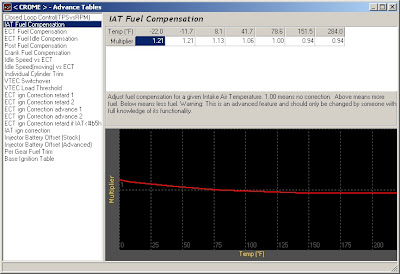You can click any of the images in this article to see a larger sharper version of that image.
- Get the latest version of Crome. I used v1.53 which supports the latest boost and fuel tool code.
- Open Crome and select File -> New to start a new bin file.
- Since advanced boost tools are only supported on the P30 ROM, I need to first export a P28 map to import into a P30 ROM. This means I'll choose P28 as the ROM for now.

- Now export the P28 maps. File -> Export Tables

- Now start a new file with a P30 ROM

- Now import the P28 maps. File -> Import Tables

- Now would be a good time to remove the checksum routine and save your bin.

- Next you'll need to install fuel tools from the plugin menu. After that's installed press Ctrl+F to set your injector size. I'll be using 1st gen DSM 450cc injectors. So the new flow rating becomes 450.

- We'll also need to change the Injector Battery Offset by pressing Ctrl+L and choosing "Injector Battery Offset" (Stock). This ensures that the injectors keep performing as programmed even when there is more or less voltage than normal. If you can't find your injectors in the more dropdown, you'll need to figure out these values for yourself.

- Time for boost! Install the Advanced Boost Tools plugin from the Plugins menu. Most people with a stock MAP sensor will just need to keep clicking next through the defaults. When it's done you'll notice you have a lot more columns in your map.

- On my small .48 AR T3 turbo, I've elected to make the following boost tables adjustment. You can adjust these values as you see fit. I always like to keep a bin saved before the tables were adjusted so I can play around with different efficiencies and retard settings to test them out as different bin files. This menu can be accessed anytime by pressing Ctrl+B.

- Next, install the "Add Extra Features" plugin from the Enhancements section of the plugins menu. This allows you to set the options page as shown in the picture. The only extra feature I use is the Boost Limit (set at 10 PSI in case the wastegate fails), so I've disabled the other shift and launch features by setting them above the rev limit. Here you can set when to enable VTEC, and obviously the rev limit too.

- I've found that disabling the following sensors gives the greatest chance of success when running the ROM in an ECU.
- Disable knock sensor
- Disable atmospheric pressure sensor
- Disable injector test circuit
- Disable VTEC speed check
- Disable VTEC coolant temp check

I've also found that bigger injectors and boost means the IAT compensation may be too aggressive and can create dangerous lean conditions. Therefore you may want to adjust the multiplier used at 151.5 and 284.

Other tips:
- Remember to use a timing light and set your ignition timing at idle to match the timing used by the map (usually 16.5 degrees)
- Your first tuning session should be done with VTEC disabled so that the low cam is tuned properly. Then you can re-enable VTEC and do high cam tuning.
Happy tuning!